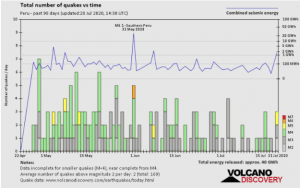
Peru is located in a seismic zone where the South American Plate moves toward the sea over the Nazca Plate causing earthquakes as a result of the thrust faulting on the interface of the two plates. According to Volcano Discovery, Peru endured 81 quakes in May of 2020. With the exception of an occasional break in seismic energy, Peruvians live with earthquakes as a daily condition. Dr. Nicos Makris, Hunt Institute Fellow, has been leading a research team of collaborators and students at SMU’s Lyle School of Engineering as well as internationally, to address this pressing issue. Their project in the Global Development Lab (GDL) focuses on seismic protection solutions for confined masonry urban housing. The in-country partner is Dr. Marcial Blondet who has dedicated over thirty years to researching the effects of seismic activity on masonry and adobe construction in Peru.
All projects in the GDL address the United Nations Sustainable Development Goals (SDGs). This effort directly targets SDG #11 which seeks to ensure that growth in housing and urban development is safe, equitable, and environmentally conscious. UN Target 11.5 highlights the importance of this effort as it sets the target to “significantly reduce the number of deaths and the number of people affected and substantially decrease the direct economic losses relative to global gross domestic product caused by disasters…with a focus on protecting the poor and people in vulnerable situations” (1).

Even middle-class urban residents in Peru’s urban environment often reside in poorly constructed confined masonry houses which, in the case of a severe earthquakes, are at the risk of suffering serious damage. Professional construction is expensive and beyond reach for the majority of Peruvians. For this reason, the seismic protection market is increasingly narrowing its focus to low-cost solutions. One of the goals of this project has been to evaluate existing low-cost solutions accessible for most Peruvians (2). Finding that even “low-cost” solutions are out of reach for most Peruvians, Dr. Makris makes an alternate proposition. Rocking isolation offers great potential as an innovative and economical alternative for seismic protection, but it has yet to be implemented as low-cost housing reinforcement. Makris’ emerging system of seismic protection could address the pressing need for affordable seismic protection of existing masonry structures.
Sam Borton, Hunt Institute Undergraduate Research Analyst, made a significant contribution to this post with his market analysis of low-cost seismic protection. The complete analysis will be released in a future post. Stay tuned to read more!
To read more about the Hunt Institute’s work to develop future-focused solutions to some of the world’s biggest problems, please click here. For the latest news on the Hunt Institute, follow our social media accounts on LinkedIn, Facebook, Twitter, and Instagram. We invite you to listen to our Podcast called Sages & Seekers. If you are considering engaging with the institute, you can donate, or sign-up for our newsletter by emailing huntinstitute@smu.edu.
- About the Sustainable Development Goals – United Nations Sustainable Development. (n.d.). Retrieved 2020, from https://www.un.org/sustainabledevelopment/sustainable-development-goals/
- Blondet, M., & Loaiza, C. (2020). Vulnerabilidad Sísmica de las Construcciones en el Perú: Informe Preliminar. Lecture presented in Pontificia Universidad Católica del Perú: Departamento de Ingeniería.


